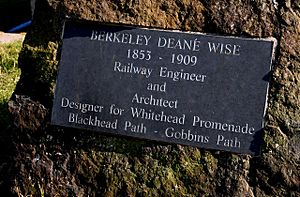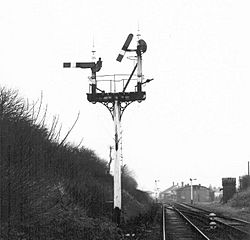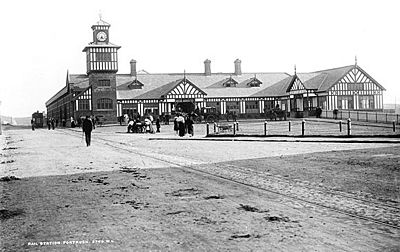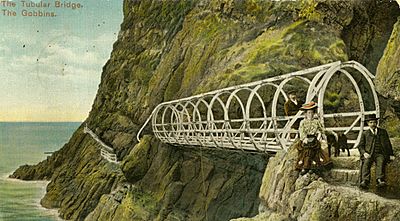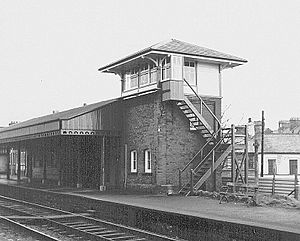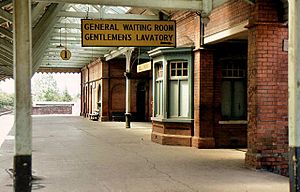Berkeley Deane Wise facts for kids
Berkeley Deane Wise (born October 2, 1855, in New Ross – died May 5, 1909, in Portrush) was a brilliant Irish civil engineer. He made a huge difference to how railways and tourism grew, especially in Northern Ireland. He designed amazing railway stations, paths, and bridges that helped people explore beautiful places.
Contents
Early Life and Education
Berkeley Deane Wise was born on October 2, 1855, in Berkeley Forest, New Ross, County Wexford. His father was James Lawrence Wise, a lawyer. His mother was Elizabeth Deane.
His family later moved to Dublin, where he grew up. He went to school in England. In 1871, he started studying at Trinity College Dublin.
Starting His Engineering Journey
Wise began his engineering career in 1872. He learned from experienced engineers like Mr. Marmaduke Backhouse and Mr. James Price. Mr. Price was the Chief Engineer for the Midland Great Western Railway of Ireland. During this time, Wise worked on building the Navan and Kingscourt Railway.
From 1875 to 1877, Wise was an Assistant Engineer for the Dublin, Wicklow and Wexford Railway. He helped build a new, long tunnel at Bray Head.
In December 1877, he moved north to become the Chief Engineer for the Belfast and County Down Railway (BCDR). He worked there for 11 years. He lived in Belfast during this time.
Improving the Railways
While at the BCDR, Wise rebuilt much of the railway line. He also made big changes to the Belfast Terminus at Queen's Quay. This included adding new signal structures. He also planned the Quoile Viaduct, a bridge to carry the railway over the River Quoile.
Wise cared a lot about railway safety. He added special "interlocking signals" at most stations. These signals made sure trains could move safely. He also invented a special "signalling staff system" that was named after him. He also brought in the unique "somersault signal" to the BNCR.
Wise became a member of the Institution of Civil Engineers in London in 1888. He was only 33 years old. He was also a vice president of the Institution of Civil Engineers of Ireland.
Leading the Northern Counties Railway
Wise's most important engineering role was as Chief Engineer for the Belfast and Northern Counties Railway (BNCR). He started this job in 1888 and stayed for 18 years.
He made sure the BNCR tracks were built to a very high standard. He used strong steel rails and good quality stone for the track base. Wise even developed his own quarry to get the best stone. He also introduced the "tablet signalling system" and the famous somersault signals. His work at York Road Station in Belfast was the biggest signal setup in Ireland at the time.
Wise also started using a new building material called "reinforced concrete" around 1900. He used it for railway structures, like the King's Bridge in Whitehead.
Designing Iconic Stations
Wise designed many of the BNCR's railway stations. His first was Larne Harbour Station, built in 1890. It was special because it had platforms for two different train track sizes. It even had a clock with two minute hands to show both English and Irish time!
One of Wise's most famous buildings is Portrush railway station, which is still standing today. The old station was too small for all the summer visitors. So, Wise designed a beautiful new building. It looked like an old English house with black beams and white walls. It had a tall clock tower and three long platforms. He also designed a large cafe and restaurant overlooking the Atlantic Ocean. Portrush station opened in 1893.
Wise gave the BNCR a special building style. Many stations had red brick, large roofs, and half-timbered designs. Two small wooden buildings he designed are now kept at the Ulster Folk and Transport Museum.
Wise worked closely with Edward John Cotton, the General Manager of the BNCR. Together, they made the BNCR the most successful railway in Ireland. They were especially good at promoting tourism.
Promoting Tourism and Beauty Spots
Besides his railway work, Wise designed many things to attract tourists. He created tea rooms, promenades, bandstands, footpaths, and even golf courses along the railway lines.
Glenariff, one of the beautiful Glens of Antrim, was called "Switzerland in Miniature." In 1889, the BNCR leased part of the Glen. Wise built paths and walkways so tourists could see the amazing waterfalls. He even built rustic shelters and a tea room, which is now a restaurant. It even had a darkroom for photographers!
Wise also built the Promenade in Whitehead. He used railway sleepers and brought in sand by train from Portrush to make a beach. He added a bandstand and fireworks displays in summer. In 1892, Wise engineered a path to the Blackhead promontory. This path included blasting through cliffs and building parts that hung over the edge. He also designed Sunshine House, a refreshment room along the path. You can still enjoy this path today.
One of Wise's most amazing engineering projects was the Gobbins Path. This path winds dramatically under tall cliffs on the Islandmagee coastline. It was designed to bring tourists to the area by train. Construction started in 1901. The 2-mile path was cut into the cliffs. It had tunnels and bridges, including two "tubular bridges" that were 70 feet long. These bridges were built in Belfast and floated to Islandmagee by barges. The entrance to the path is a tunnel through rock, known as "Wise's Eye." Two parts of the cliffs were even named after him: Deane's Head and Berkeley's Point.
The first part of the Gobbins Path opened in 1902. It was advertised as having "no parallel in Europe" as a cliff walk. Tourists would travel by train to Whitehead or Ballycarry. Then they would take a horse-drawn carriage to the Gobbins. The path became very popular, almost as famous as the Giants Causeway. Wise planned to extend it even further.
An extension opened in 1906, but then Wise became ill. The full plan was too expensive, so only a part of the extension was built. After Wise left the company, the final extension opened in 1908. It included a spectacular suspension bridge. The Gobbins Path closed in 1940 during World War II. It reopened in 1951 but closed again in 1961 due to landslides and maintenance issues.
After many years, the Gobbins Path was rebuilt starting in 2011. The new path, with its new walkways and bridges, opened in 2015. It cost £7.5 million.
Life Outside Work
In the later part of his career, from 1896 to 1906, Wise lived in Jordanstown. In his free time, he kept poultry. He also attended Whiteabbey Presbyterian Church.
In 1896, Wise took his nephew, Freeman Wills Crofts, as an apprentice. Crofts worked for the BNCR until 1929. Later, Crofts became a famous detective novel writer. He wrote his first book, The Cask, during a long illness. He then left his railway job to write full-time.
Later Life and Legacy
Wise's health sadly declined, and he moved to Portrush in 1906. He died there on May 5, 1909, near his famous Portrush railway station.
He was buried in the City Cemetery, Belfast. Many of his railway friends attended his funeral. Wise was survived by his son, James Berkeley Wise, who also became a railway engineer, and his wife, Leah.
Berkeley Deane Wise was a truly outstanding civil engineer. An obituary said that his designs were "original and artistic." It also noted that he made many of the beautiful places in the country easy to visit without spoiling their natural charm. He was known for his kind and gentle nature.
List of Works
- Dundrum Harbour, 1884.
- Larne Harbour railway station, 1890.
- Glenarriff Paths, Bridges and Tearoom, 1889 & 1891.
- Whitehead Promenade and Blackhead Path, 1892.
- Portrush railway station, 1893.
- Ballymoney railway station, 1893.
- Greenisland railway station, 1893.
- Northern Counties Hotel, Portrush (alterations and additions), 1884 & 1892.
- Carrickfergus railway station, 1895.
- Whiteabbey railway station (down platform), 1896.
- Jordanstown railway station (down platform), 1896.
- Glynn railway station, 1896.
- Trooperslane railway station, 1896.
- York Road railway station Belfast (Port Cochere, Clock Tower, Midland Hotel), 1894–1898.
- Portstewart Tramway Terminus, 1899.
- Whitehead railway station (extension), 1900.
- The Gobbins Path, Islandmagee, 1902.
- Whitehead Beach Promenade, Whitehead.
- Laharna Hotel, Larne (alterations), 1905.
- Limavady railway station, 1906.
- Antrim railway station, 1902.
- Ballymena railway station, 1904.


